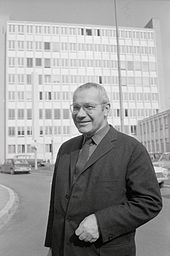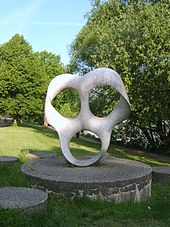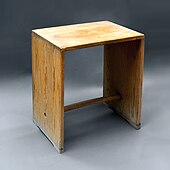Max Bill




Max Bill (born December 22, 1908 in Winterthur ; † December 9, 1994 in Berlin ) was a Swiss architect , versatile artist with a focus on visual and applied arts - including sculpture , graphics , industrial design , painting (representative of the Zurich School of Concrete ) and typography , university professor and national councilor of the Swiss Confederation .
Vocational training, studies and artistic creation
Max Bill did an apprenticeship as a silversmith at the Zurich School of Applied Arts from 1924 to 1927 . In 1925, at the age of 17, he was invited to the Exposition Internationale des Arts Décoratifs et industriels moderne in Paris with his student work , where he was particularly impressed by the works of Le Corbusier , Konstantin Stepanowitsch Melnikow and Josef Hoffmann . 1927–1928 he studied at the Bauhaus in Dessau , where Josef Albers , Wassily Kandinsky , Paul Klee , László Moholy-Nagy and Oskar Schlemmer taught at the time.
From 1929 Bill worked both practically and theoretically as an architect, and from 1932 as a sculptor, graphic artist and painter. From 1932 to 1937 he was a member of the Abstraction-Création artist movement in Paris . In 1936 he defined his conception of “Concrete Art” in an exhibition catalog of the Kunsthaus Zürich and became one of its most important representatives in the Zurich School of Concrete - an art movement in painting originating from the Zurich School of Applied Arts - and the Association of Modern Swiss , founded in 1937, inspired by it Artist - Alliance . From 1936 he was also active as a publicist and in 1941 founded the Allianz publishing house. In 1938 he became a member of the Congrès International d'Architecture Moderne .
Bill created numerous sculptures and exhibited many in galleries and museums . He was a participant in documenta 1 (1955), documenta II (1959) and documenta III (1964) in Kassel . His first exhibition in the USA took place in 1963 in the gallery of George William Staempfli in Manhattan , New York , retrospectives 1968–1969 in the Kunsthaus Zürich , 1974 in the Albright-Knox Art Gallery in Buffalo and in the Los Angeles County Museum of Art as well 1988 in the Solomon R. Guggenheim Museum in New York.
From 1961 to 1964, as head of the “Education and Design” department, he was an architect for Expo64 - the Swiss National Exhibition in Lausanne .
Teaching and lecturing activity, book author
In 1944/1945 Bill received his first teaching position at the Zurich School of Applied Arts. During this time he made friends with Georges Vantongerloo and František Kupka . From 1951 to 1953 he co-founded the Ulm University of Design (HfG) and designed its school building. From 1953 to 1956 he was their first rector. In 1957 he returned to Zurich . Between 1967 and 1974 Bill held the chair for environmental design at the Hamburg University of Fine Arts . In 1973 he became an associate member of the Royal Flemish Academy of Sciences and Arts of Belgium in Brussels and in 1976 a member of the Academy of Arts in Berlin.
In addition to his teaching activities , he has authored numerous books, lectured on art, architecture, and design and appeared at conferences around the world. His books include in particular those about Le Corbusier, Wassily Kandinsky, Ludwig Mies van der Rohe and Theory of Art .
Political life
In his younger years Bill - like his colleague Richard Paul Lohse - was a committed anti-fascist , protested against the cold war , nuclear armament , and the Vietnam War, and campaigned for environmental protection issues as early as the 1950s . Max Bill sympathized with Silvio Gesell's free economics . He became acquainted with her through his architect colleague Hans Bernoulli . Together with Gesell and others, he set up the Swiss Free Trade Association. In the free-economic-anarchist magazine last politik published by Hans Timm there is also an advertisement with which Max Bill offers his services. Your text read:
«Dessau: max bill, designer bauhaus, dessau. drafts for architecture, advertising, graphics, interior design (metal, painting, wood, textile) only very modern »
He was observed by the Swiss state security for half a century , beginning in October 1936 after he hid the journalist Alfred Thomas who was persecuted in Nazi Germany . Thomas was expelled from the country in May 1936 ; his further fate is unknown. Bill was fined for housing for failing to register the refugee with the residents' registration office. Other prominent political refugees from fascist Italy and Germany first came to stay with him after they fled to Switzerland.
From 1961 to 1968 Bill was a member of the Zurich City Council and from 1967 to 1971 of the Swiss National Council . Ported by the State Ring of Independents , he was politically active as a non-party.
Private life
Bill was the nephew of Ernst Samuel Geiger and often stayed on his estate in Ligerz . Bill met the Mulhouse-born actress and variety artist Maria Benz in 1929 , and she lived with him for a short time at Stadelhoferstrasse 27 in Zurich. Bill gave her the name «Nusch», and she also worked for him as an assistant. The immigration police wanted to expel Nusch, and the planned marriage to Nusch failed due to the resistance of his father Erwin Bill. Max Bill then married the cellist and photographer Binia Spoerri in 1931 , who died in 1988. From this, his first marriage, the only child was Jakob Bill (* 1942). His son David Bill, (1976-2018) was also active as an artist.
Max Bill's son, Jakob Bill, founded the Swiss max, binia + jakob bill foundation in 1996 , thus realizing the idea his father had after the death of his first wife. The purpose of the foundation is to collect and maintain the works of the Bill family, to promote scientific research, and to disseminate and publish them for those interested.
Bill had been in a relationship with the art historian Angela Thomas since 1974 , who had accompanied him on many journeys for twenty years and during this time was the most important conversation partner for his work. Since 1991 he was married to her second marriage.
On December 9, 1994, while he was waiting for a flight to Zurich at Berlin-Tegel Airport , Max Bill collapsed as a result of a heart attack and died while being transported to a hospital. His widow wanted to bury the urn in the pavilion sculpture he designed in Zurich , in accordance with Bill's request . When the city refused, they exhumed them and scattered the ashes on the sculpture.
Since Bill had rejected his son's proposal for a foundation, the estate was divided between the son and the widow, Angela Thomas, according to his will. She founded the max bill georges vantongerloo foundation and now lives with the filmmaker Erich Schmid , with whom she has been married since 1998, in Bill's home and studio in Zumikon .
honors and awards
Max Bill has received numerous prizes and honors for his works:
- 1964: Honorary Membership / Honorary Member of the American Institute of Architects , AIA
- 1968: Art Prize of the City of Zurich
- 1979: Culture Prize of the City of Winterthur
- 1982: Kaiserring of the city of Goslar
- 1988: Premio Marconi per Arte e Scienzia, Bologna
- 1988: Piepenbrock Prize for Sculpture , Osnabrück
- 1990: Helmut Kraft Prize for Fine Arts, Stuttgart
- 1993: Praemium Imperiale of the Japanese Emperor , Tokyo
- 2004: Max-Bill-Platz in the Oerlikon district , Zurich (completed in 2007), with Max-Bill-House
- 2008: Max-Bill-Platz in his home town Moosseedorf .
- 2017: Max-Bill-Weg at the Kunsthaus in the city of Rehau .
- 2011: Max-Bill-Strasse in Schwabing-Freimann in Munich .
Works
architecture

- Max Bill residential and studio building in Zurich (1932–1933)
- Swiss Pavilion at the 6th Triennale di Milano in Milan (1936)
- Swiss Pavilion at the 9th Triennale di Milano (1951)
- School building of the Ulm University of Design (HfG) (1953–1955)
- Pavilion of the City of Ulm at the Baden-Württemberg State Exhibition in Stuttgart (1955)
- Buildings for Expo 64 in Lausanne (1961–1964): Expo theater
- Max Bill residential and studio building in Zumikon , Canton of Zurich (1967–1968)
design
- The Ulm stool is one of Max Bill's most famous works . This can be used as a seat , side table , lectern , part of a shelf , tray and carrying aid. The furniture is now being manufactured in a licensed re-edition by the Zurich company WB Form analogous to the original, the spruce and beech wood comes from Switzerland.
- Another well-known design work are the deliberately simple dials for Junghans bracelet , kitchen and wall clocks , which are available again as a re-edition.
Sculptures
- Infinite loop. Plaster of paris on steel frame with a superficial aluminum spray process, 1935–1937, destroyed on Lake Zurich in 1948
- 15 variations on a theme , 1938
- Rhythm in space. Granite, on the Kennedy Bridge of the Hamburg Outer Alster , 1947–1948
- Family of five half balls. White artificial stone, Mathematical Institute of the University of Karlsruhe , 1965–1966
- Lavoitobel Bridge, Tamins , 1966–1967
- Radiation from penetration , 1966–1969, Museo cantonale d'arte di Lugano .
- Rotation around expanding white. Zurich, 1981
- Einstein monument. Ulm, 1982
- Pavilion sculpture. Zurich, 1983
- Continuity . Rosa-Sardo -Granit, Deutsche Bank AG Frankfurt am Main , 1986, 2011 moved to the park next to Deutsche Bank.
- statues-group of three . DaimlerChrysler corporate headquarters in Stuttgart-Möhringen , 1989, since 2006 Mercedes-Benz Center of the Mercedes-Benz World in Stuttgart-Bad Cannstatt
- Endless stairs in Ludwigshafen am Rhein (1991) and on the seminar square in Dessau
- Rhythm in space. European Patent Office , Munich , 1994
- Raumplastik - Berlin thanks France. Berlin Mitte district , 1994
- Gemini from a quarter sphere . African granite, 1982, forecourt Theater Trier
- Family of five half spheres in front of the Mathematical Institute of the University of Karlsruhe
Exhibitions
- max bill , Kunsthaus Zürich, 1968/69 (with catalog)
- max bill retrospective , Academy of the Arts, West Berlin, 1976
- max bill retrospective , Schirn Kunsthalle, Frankfurt am Main, 1987 (with catalog)
- max bill , Wilhelm-Hack-Museum, Ludwigshafen am Rhein, 1990 (with catalog)
- Max Bill , Pinacoteca comunale Locarno, 1991 (with catalog)
- max bill , Edward Totah Gallery, London, 1991
- max bill , Fondation Saner Studen, 1993 (with catalog)
- max bill, the graphic series , District Office Esslingen near Stuttgart, 1995 (with catalog)
- Max Bill. A retrospective , Kunstmuseum Stuttgart , September 10, 2005 - January 8, 2006 (with catalog)
- max bill , Palazzo reale, Milano, 2006 (with catalog, takeover of the exhibition at the Kunstmuseum Stuttgart)
- Max Bill: without a beginning, without an end . Museum Marta Herford, 2008 (with catalog)
- max bill 100 , Pinacoteca communale Locarno
- max bill. five decades , Annely Juda Fine Art, London, 2011 (with catalog)
literature
- Max Bill: Function and Functionalism. Writings 1945–1988. Benteli, Bern 2008, ISBN 978-3-7165-1522-8 .
- Max Bill, retrospective. Sculptures, paintings, graphics 1928–1987. (Texts by Christoph Vitali, Eduard Hüttinger, Max Bill.) Catalog Schirn Kunsthalle, Frankfurt / Zurich / Stuttgart 1987, ISBN 3-922608-79-5 .
- Annemarie Bucher: Max Bill. In: Historical Lexicon of Switzerland . August 10, 2004 , accessed April 12, 2020 .
- Thomas Buchsteiner, Otto Lotze: max bill, painter, sculptor, architect, designer. Ostfildern-Ruit 2005, ISBN 3-7757-1641-6 .
- Luciano Caramel, Angela Thomas: Max Bill. Pinacoteca Communale Casa Rusca, Locarno / Fidia Edizione d'Arte, Lugano 1991, ISBN 88-7269-011-0 .
- Jürgen Claus: The energy field of color: Max Bill. In: Jürgen Claus: Art today. Rowohlt Verlag, 1965.
- Bernd Grönwald : Max Bill in Weimar. In: Bildende Kunst, 8. Berlin 1987, pp. 349–351.
- Gerd Fischer: The Colossus of Frankfurt: The "Continuity" of Max Bill. In: Communications of the German Mathematicians Association, Issue 4/1999, pp. 22–23.
- Eduard Hüttinger : Max Bill. abc Verlag, Zurich 1977, ISBN 3-85504-043-5 .
- Eduard Hüttinger: Max Bill. Edition Cantz, Stuttgart 1987 (extended edition) ISBN 3-922608-79-5 .
- Gregor Nickel, Michael Rottmann: Mathematical Art: Max Bill in Stuttgart. In: Communications of the German Mathematicians Association, Volume 14, Issue 3/2006, pp. 150–159.
- Arturo Carlo Quintavalle: Max Bill. Università Commune Provincia di Parma, Quaderni 38, 1977.
- Frank Raberg : Biographical Lexicon for Ulm and Neu-Ulm 1802-2009 . Süddeutsche Verlagsgesellschaft im Jan Thorbecke Verlag, Ostfildern 2010, ISBN 978-3-7995-8040-3 , p. 43 .
- Thomas Reinke, Gordon Shrigley: Max Bill: HfG Ulm: Drawing and Redrawing: Atelierwohnungen, Studentenwohnturm. marmalade, 2006, ISBN 978-0-9546597-1-4 .
- Emil Schwarz: In the knowledge of the time or The sense that beauty creates, homage to Max Bill. A poetic retracement with the essay Reality or Reality . NAP Verlag, Zurich 2010, ISBN 978-3-9523615-4-2 .
- Werner Spies : Continuity. Granite monolith by Max Bill. Busche, Dortmund 1986, ISBN 3-925086-01-3 .
- René Spitz: hfg ulm. the look behind the foreground. the political history of the ulm college for design 1953–1968. Stuttgart / London 2002, ISBN 3-932565-16-9 . (On the history of the Ulm School of Design from its founding in 1953 to its closure in 1968.)
- Angela Thomas: Max Bill and his time. 2 volumes. Scheidegger & Spiess, Zurich.
- Volume 1: With subversive gloss (1908–1939). 2008, ISBN 978-3-85881-227-8 .
- Volume 2: Only small spirits keep order (1939–1994). 2012, ISBN 978-3-85881-228-5 .
- Jakob Bill: Max Bill at the Bauhaus. Benteli, Bern 2008, ISBN 978-3-7165-1554-9 .
- Udo Weilacher: Continuity (Max Bill). In: Udo Weilacher: Visionary Gardens. The modern landscapes by Ernst Cramer. Basel / Berlin / Boston 2001, ISBN 3-7643-6568-4 .
- Roberto Fabbri: Max Bill in Italia. Lo spazio logico dell'architettura. Bruno Mondadori Editore, Milan 2011, ISBN 978-88-6159-606-1 .
- Roberto Fabbri: Max Bill. Espaces. Infolio Éditions, Gollion - Paris 2017, ISBN 978-2-8847-4463-8 .
- Da Silva Paiva, Rodrigo Otávio: Max Bill no Brasil. 2011, ISBN 978-3-943347-13-5 .
- Hans Rudolf Bosshard : Max Bill versus Jan Tschichold . The typography dispute of modernity. Niggli, Sulgen [and a.] 2012, ISBN 978-3-7212-0833-7 .
- Ina Busch, Simon Spierer , Ina Boike, Lutz Fichtner, Valentina Anker, Ernst Wegener, Wolfgang Fuhrmannek: A forest of sculptures. Simon Spierer Collection. Catalog for the exhibition in the Hessisches Landesmuseum Darmstadt. Hatje Cantz Verlag, 2005, ISBN 3-7757-1609-2 .
- Daniel P. Meister, Dagmar Meister-Klaiber: simply complex - max bill and the architecture of the Ulm University of Applied Sciences. Scheidegger & Spiess, Zurich 2018, ISBN 978-3-85881-613-9 .
Movie
- max bill - the absolute eye measure. Film by Erich Schmid , 93 min., 35mm + DVD, Ariadnefilm, Zumikon 2008.
- Max Bill. Script and direction: Klaus Peter Dencker . (TV report, 12 minutes.) Saarländischer Rundfunk , 1976.
- 22 questions for Max Bill. Film by Georg Radanowicz , 16mm, 1969.
Web links
- Publications by and about Max Bill in the Helveticat catalog of the Swiss National Library
- Literature by and about Max Bill in the catalog of the German National Library
- Annemarie Bucher: Bill, Max. In: Historisches Lexikon der Schweiz .
- Albrecht Juerg: Bill, Max. In: Sikart
- Website of the Max Bill Georges Vantongerloo Foundation
- Website of the Max, Binia + Jakob Bill Foundation
- Materials by and about Max Bill in the documenta archive
- Entry at the RuhrKunstMuseen RKM on the Infinite Loop in Essen
- 22 questions to Max Bill from Georg Radanowicz, 1969, in the media archive of the ZHdK
Individual evidence
- ↑ Florian Dreher: The politics of small steps or the cautious person. Max Bill as a politician (Nextroom.at; April 14, 2014) ; accessed on January 14, 2017.
- ↑ For the journal last policy see Dadaweb: last policy ; accessed on January 14, 2017.
- ↑ See MaxBill.ch: Kulturtage Haus Bill (October 2016). S.40f ; accessed on January 14, 2017.
- ↑ Erich Schmid: The political bill. In: maxbillfilm.ch , November 21, 2007.
- ↑ Angela Thomas: with a subversive shine. max bill and his time. volume 1: 1908-1939. Zurich: Scheidegger & Spiess, 2008, p. 280.
- ↑ Thomas 2008, p. 280 and p. 289.
- ↑ ibid., Pp. 304-306.
- ↑ https://www.luzernerzeitung.ch/kultur/in-erinnerung-an-david-bill-ld.1058971 , accessed on August 16, 2020.
- ↑ https://www.kunstundkulturstiftungbaselland.ch/wp-content/uploads/2015/11/BillundHinterreiter.pdf , accessed on August 16, 2020.
- ↑ a b Max Bill - the absolute sense of proportion. In: maxbillfilm.ch (film by Erich Schmid).
- ^ Max-Bill-Strasse in Munich Schwabing-Freimann. Retrieved December 17, 2018 .
- ↑ max, binia + jakob bill foundation. Retrieved November 22, 2018 .
- ↑ Max Bill. A retrospective In: Kunstmuseum Stuttgart , accessed on March 31, 2016.
| personal data | |
|---|---|
| SURNAME | Bill, Max |
| BRIEF DESCRIPTION | Swiss architect, artist and designer |
| DATE OF BIRTH | December 22, 1908 |
| PLACE OF BIRTH | Winterthur , Switzerland |
| DATE OF DEATH | December 9, 1994 |
| Place of death | Berlin , Germany |









